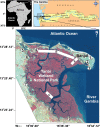A socio-ecological assessment aiming at improved forest resource management and sustainable ecotourism development in the mangroves of Tanbi Wetland National Park, The Gambia, West Africa
- PMID: 22351596
- PMCID: PMC3390577
- DOI: 10.1007/s13280-012-0248-7
A socio-ecological assessment aiming at improved forest resource management and sustainable ecotourism development in the mangroves of Tanbi Wetland National Park, The Gambia, West Africa
Abstract
Although mangroves dominated by Avicennia germinans and Rhizophora mangle are extending over 6000 ha in the Tanbi Wetland National Park (TWNP) (The Gambia), their importance for local populations (both peri-urban and urban) is not well documented. For the first time, this study evaluates the different mangrove resources in and around Banjul (i.e., timber, non-timber, edible, and ethnomedicinal products) and their utilization patterns, including the possibility of ecotourism development. The questionnaire-based results have indicated that more than 80% of peri-urban population rely on mangroves for timber and non-timber products and consider them as very important for their livelihoods. However, at the same time, urban households demonstrate limited knowledge on mangrove species and their ecological/economic benefits. Among others, fishing (including the oyster-Crassostrea cf. gasar collection) and tourism are the major income-generating activities found in the TWNP. The age-old practices of agriculture in some parts of the TWNP are due to scarcity of land available for agriculture, increased family size, and alternative sources of income. The recent focus on ecotourism (i.e., boardwalk construction inside the mangroves near Banjul city) received a positive response from the local stakeholders (i.e., users, government, and non-government organizations), with their appropriate roles in sharing the revenue, rights, and responsibilities of this project. Though the guidelines for conservation and management of the TWNP seem to be compatible, the harmony between local people and sustainable resource utilization should be ascertained.
Figures




References
-
- Aikins MK, Pickering H, Alonso PL, D’Alessandro U, Lindsay SW, Todd J, Greenwood BM. A malaria control trial using insecticide-treated bed nets and targeted chemoprophylaxis in a rural area of The Gambia, West Africa. Transactions of the Royal Society of Tropical Medicine and Hygiene. 1993;87:25–30. doi: 10.1016/0035-9203(93)90172-M. - DOI - PubMed
-
- Albaret J-J, Simier M, Darboe FS, Ecoutin JM, Raffray J, Tito de Morais L. Fish diversity and distribution in the Gambia estuary, West Africa, in relation to environmental variables. Aquatic Living Resources. 2004;17:35–46. doi: 10.1051/alr:2004001. - DOI
-
- Alongi DM. Mangrove forests: Resilience, protection from tsunamis, and responses to global climate change. Estuarine, Coastal and Shelf Science. 2008;76:1–13. doi: 10.1016/j.ecss.2007.08.024. - DOI
-
- Avau J, Cunha-Lignon M, Myttenaere B, Godart M-F, Dahdouh-Guebas F. The commercial images promoting Caribbean mangroves to tourists: Case studies in Jamaica, Guadeloupe and Martinique. Journal of Coastal Research. 2011;64:1277–1281.
-
- Bandaranayake WM. Traditional and medicinal uses of mangroves. Mangroves and Salt Marshes. 1998;2:133–148. doi: 10.1023/A:1009988607044. - DOI
Publication types
MeSH terms
LinkOut - more resources
Full Text Sources

